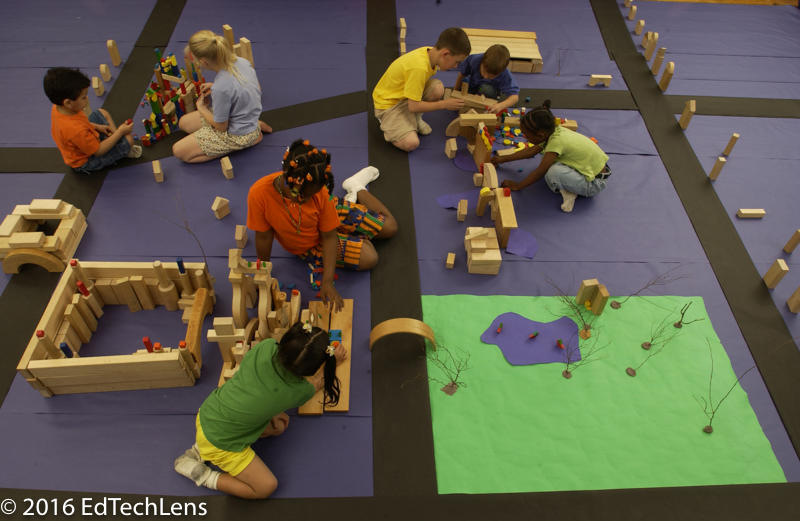
How Will I Teach All This in One Year?
For educators unsure how they’ll find time to satisfy the demands of this year’s curriculum, Loriana Romano has some helpful advice: You can make the most of your time by using science to integrate subjects. Noting that teachers feel pressure to focus on math and language arts, she says that “when you add science, you can tie all three subjects together into one hour-long segment that is dynamic and motivating for students.”
Addressing Curriculum Expectations in a Meaningful Way
Instead of compartmentalizing subjects, she recommends a cross-curricular approach, which allows you to create activities around a purpose.
For example, a lesson on the rainforest may include creation of a mixed media collage showing jungle flora and fauna, and students will need to read texts to learn about what plants and animals they could include. “An activity like this requires reading strategies like inferring and predicting, and by integrating reading practice into the rainforest project, students have a purpose for learning these skills,” she says. “They can see everything is connected and that there’s a purpose for learning it. So instead of reading a random text, they’re reading a text that’s connected to their lesson and there’s a reason to learn what’s in it.”
Science Provides the “Big Idea”
The big idea may be “conservation,” which is the kind of scientific idea that provides lots of great jumping off points into other subjects. But if teachers jump straight in with the big idea of conserving the rainforest, students are likely to start off being unclear about what the rainforest is, where it’s located, and why it’s important. Romano says. “It’s important for students to develop their own ideas in order to make meaningful connections. You can start with a wonder wall where students ask questions about conservation, which helps teachers see their preconceptions,” she explains.
When developing a unit on conservation, for example, you could use a video on the Amazon River which would serve as a source of information for students to create their own write-ups or even dramatic sketches – but always with a focus on the main point, Romano says. Once students have developed a good understanding of the idea, teachers can share facts about the destruction of the rainforest and loss of biodiversity, and students will have some context for the idea of conservation.
“Once students know the details, they can come to the conclusion themselves that the rainforest is something vital that needs to be protected,” Romano says. “We can’t tell students that something is important and should be conserved. That’s a big idea they should eventually realize themselves as they work though the unit.”
Students develop facility in understanding big ideas when they approach learning with a cross-curricular approach. This also helps them meet NGSS Crosscutting Concepts standards.
Question of the Week
In her class, Romano sometimes uses a question of the week that students mull over as they work through their projects from Monday to Friday, which gives them the experience of working on something continuously. By framing the week’s learning this way, she finds students are more invested in what they are asked to do and that activities are more meaningful for them.
Experimenting in Your Own Classroom
Romano recommends the first step of talking with colleagues to share ideas about how to use science as a cross-curricular frame. “Then spend some time with your curriculum document [the Canadian equivalent of Common Core Standards]. Look for natural connections that arise among subjects and goals. Start mind mapping possible connections. Once you have it all in front of you, it’s easy to see how topics fit together,” she says.
She also suggests getting students involved. “You can have them look at the curriculum document,” she says. “Let them see what’s expected of them for the year. Point out what they’re going to do to learn about habitat, for example and ask, ‘What do you think? Is this a good way to learn about habitat?’ Help them see how they contribute to their own learning. It gets them very engaged.”
Romano says that as educators are increasingly expected to cover more information in the same school year, a cross-curricular approach built on a science foundation will buy teachers time. Fewer transitions, less distraction, and more involved, more interested students all contribute to a better, more productive flow to the day. “True authentic learning happens when students are actually engaged,” she says. “Integrating science across curricula enables a more comprehensive approach and creates an environment where students naturally reassess their thinking and are engaged in constructing their own meaning.”
About Loriana Romano: An elementary school teacher in Toronto, Ontario, Romano attended the University of Toronto and is a graduate of the Master of Teaching program at OISE/UT. She began her teaching career in 2005 and has taught both in the junior and intermediate divisions. She is an engaging and dynamic teacher who enjoys integrating 21st century learning into her classroom practice through inquiry, Genius Hour projects, and technology. She developed her website, www.teachingrocks.ca, with her friends and colleagues Elita Saulle and Lisa Papa in order to provide resources, strategies, and ideas to assist teachers in creating engaging, effective, and meaningful learning environments.

